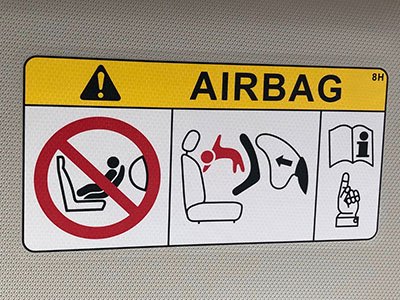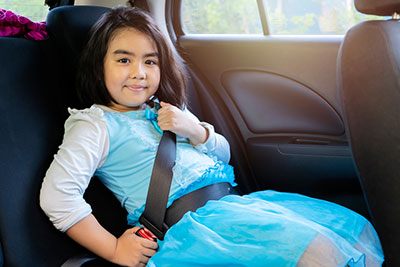As a parent, keeping your child safe is the highest priority. From car seats to booster seats and beyond, you want to ensure your family is secure if an accident occurs. But what about seat belts with air bags specifically?
In this blog post, we'll examine all the best safety features available to determine whether air bags can work safely with seat belts. So buckle up - let's get started!
More...
Take Away Key Points:
Table of Contents
- Seat belt & airbag: A life-saving combination!
- 1. Why do we need both car seat belts and airbags?
- 2. Airbag systems protect you well, so why do you still need seat belts?
- 3. How effective are airbag systems/seat belts?
- 4. Can you accidentally trigger an airbag when you're not in a car crash?
- 5. Can children combine car seat belts with airbag cushions?
- 6. Why is it mandatory for children to wear rear seat belts?
- FAQs
- Summary
Seat belt & airbag: A life-saving combination!
Motor accidents have caused more than one-third of reported spinal cord injuries, as the National Spinal Core Injury database states. In addition, the officials report other severe injuries, such as herniated discs, vertebral fractures, whiplash, and similar injuries. But can we prevent this?
The experts agree it is possible to eliminate the high risk of these injuries if we correctly wear the car seat belt and airbag systems. But how to do so? Read below.
1. Why do we need both car seat belts and airbags?

Seat belt systems and airbags are interrelated. An airbag without a seat belt can cause severe injuries, resulting in fatal outcomes. So, you must wear a car seat belt in crash forces. In addition, car seat laws state that all passengers must wear seat belts while inside motor vehicles.
However, more and more people do not wear seat belt systems in modern vehicles, as they claim that airbags will provide the necessary protection during car accidents. But this is wrong for multiple reasons.
Firstly, the airbag is designed to work together with the seat belt to reduce fatal outcomes in car accidents. They are the first line of defense for protecting all passengers on the road.
The seat belt restraints passengers, keeping them from ejection from the car seat and flying forward toward the dashboard or out of the motor vehicle. If you have been in a car collision, you have probably noticed your head snapped forward at impact, although the seat belt kept your body in the correct seating position. The same rules apply to low-speed collisions. Thus, seat belt safety systems protect you from fatal outcomes.
So, what do airbags do?
Airbag systems help protect your chest, neck, and head in high-speed car collisions. The moment the crash starts, the sensors activate and measure the impact severity. The severity of the accidents will send signals to fill the bags with gas instantly. Thus, the cushion protects the seat occupant from severe injury and fatal consequences.
Where are airbag cushions located?
The driver's cushion is in the steering wheel, while the passenger is in the dashboard. However, modern motor vehicles also include supplemental knee cushions mounted lower. The knee cushions are made to prevent severe knee injuries.
2. Airbag systems protect you well, so why do you still need seat belts?
There are multiple reasons why you must wear seat belts, even though airbag systems will protect you well. Some of them include:
- Holding your body inside the car seat: The airbag protection will not be helpful if your body flies right past it. Instead, you need a shoulder strap and a lap belt to keep you well-positioned in the car seat. In case of an accident, the motor vehicle stops very quickly. You can sustain even worse injuries if you're not wearing seat belts. So, the seat belts will offer the best restraint system and allow a more gradual stop.
- Keeping your body inside the vehicle and in the right cushion position: Seat belts are always the primary locking mechanism to protect your body from accidents. The airbag systems are the secondary protective car seat products and supplemental restraints. They can never replace seat belts. The airbag offers additional support for passengers in the vehicle, with the premise that the passengers use seat belts. The airbag will protect you only if you wear a seat belt.
- Distributing the energy created by the forces around your body, protecting you from severe impacts: Each car seat manufacturer strongly urges passengers to wear seat belts as the primary means of protection in the vehicle. But, in more powerful vehicle crashes, even seat belts sometimes cannot protect you well from hitting inner objects in the vehicle and causing injuries.
3. How effective are airbag systems/seat belts?

The University of Pittsburgh Medical Center presented an eight-year study combining airbag systems and seat belts to test how effectively the combination could prevent spinal cord injuries.
The medical record included 7,170 patients suffering from spinal cord injuries, divided into four categories:
- Passengers with no restraint systems
- Passengers with seat belts only
- Passengers with airbag protection only
- Seat belts and airbag cushions together.
The study showed that most injuries (36-38%) involved the neck. The study also showed that the fourth category of passengers - those wearing seat belts and airbag protection suffered the least. The two restraint systems prevented ejection from the car seat and optimized the head, neck, and chest.
For this reason, the NHTSA strongly urges all drivers to leave ten inches between the wheel and breastbone in the vehicles to prevent injuries from airbag deployment. Ten inches is a good safety margin, as the main risk zone appears during two to three inches of airbag inflation in a car crash.
4. Can you accidentally trigger an airbag when you're not in a car crash?
Yes, you can accidentally deploy the airbag on the road. Sometimes, the system will turn on due to a car hitting a curb or a pothole. The accident will not only cause severe injury to the passengers, but the driver can also lose control of the car and result in a severe crash.
Therefore, only the passengers that are strong enough can sit in the front car seats, as they can endure the pressure of the cushions better than younger passengers.
5. Can children combine car seat belts with airbag cushions?
When used with seat belts, the safety cushions work well to protect teenagers and adults. But, safety cushions can be very dangerous for children, especially those not properly restrained in their car seats.
The AAP and car seat manufacturers strongly urge parents to restrain their children properly in car seats. All children aged less than 13 years old must be properly restrained in the back seat of the vehicle, using the proper rear-facing/forward-facing car seat, booster mode, or a car seat belt.
Once the children are 13 years old and older, they can sit in the front seat. But they must wear seat belts to protect them in crashes.
And, if you must install a rear-facing infant car seat in the front seat, you must turn off the safety cushions. Child seats cannot hold the pressure the cushions provide, so your children can suffer fatal outcomes.
The experts also recommend you install the rear-facing infant seats as far away from the safety cushions as possible.
6. Why is it mandatory for children to wear rear seat belts?

All passengers traveling in the back seat of the motor vehicle, not only children, have 44% more chances of avoiding severe injuries and death compared to those unrestrained. In the case of SUVs and their back seats, the seat belts are 73% more efficient when preventing death and other severe injuries in case of a motor vehicle crash.
The seat belts must fit the child passengers - the shoulder belt must cover the chest, never the neck, and the lap belt must cover the upper thighs, never the stomach. Otherwise, the children must use the booster seat or other car seats for protection.
In addition, rear-facing, forward-facing, and booster seat types use seat belts or the LATCH system for proper installation in the back seat. In addition, they have safety harnesses (again, a variety of smaller seat belt system) with straps to add extra protection in car accidents.
FAQs
Do seat belts work with airbags?
Yes, seat belts best work with airbags as the primary and supplementary restraint models. When the safety cushions activate, the seat belt helps prevent ejections and protects the occupants' bodies.
Why are seat belts and airbags important?
Seat belts and airbags are important as they keep passengers safe and sound on the road. The belts keep the passengers in the proper seating position, while the cushions prevent hitting heads into dashboards, windshields, steering wheels, and other car parts. In addition, they keep the head, neck, spine, and chest optimal.
Is a seat belt necessary for airbags?
Yes, a seat belt is necessary for airbags; if not, the cushions without the shoulder and lap belts will cause severe injuries to the passengers.
Do airbags work if the seat belt is off?
Airbags are not supposed to deploy if passengers do not wear seat belts.
Summary
As you have seen, seat belts with airbags system is the best combination to keep all passengers safe while on the road. You must always use both restraint models to avoid severe injuries and death.
Do not try to interchange the systems, as they will not be effective when separated. And teach your children to use both as well.
